Visiting the Byzantine Churches in Thessaloniki. An important center during the Byzantine Empire, Thessaloniki is architecturally blessed, with many extraordinary churches, representing the whole of the Byzantine era. UNESCO has designated thirteen of the churches in Thessaloniki world heritage monuments.
This selection of six churches in Thessaloniki – some grand and central, others small and nearly secret, give you a broad and varied experience of Byzantine splendor, with mosaics that are considered – along with those of Ravenna – to be masterpieces of early Christian art.
The Byzantine Churches of Thessaloniki are an essential part of the city experience, and a beautiful introduction to a significant era in the city’s history.
Related post: Best Things to Do in Thessaloniki – Sights, Activities, and Cultural Experiences
Useful Notes on Visiting Churches in Thessaloniki:
Even when churches have official opening hours posted, you may not find them open. This is especially true of the smaller churches. Generally speaking, the earlier, the better.
Modest dress – with knees and shoulders covered – is expected for both men and women.
The Finest Byzantine Churches in Thessaloniki
These six churches will introduce you to the beauty of Byzantine art and architecture from the 5th through the 14th centuries. For more history and context, you can follow with a visit to Thessaloniki’s stellar Museum of Byzantine Culture, one of the city’s key museum experiences.
Agios Dimitrios – The Church of the Patron Saint of Thessaloniki
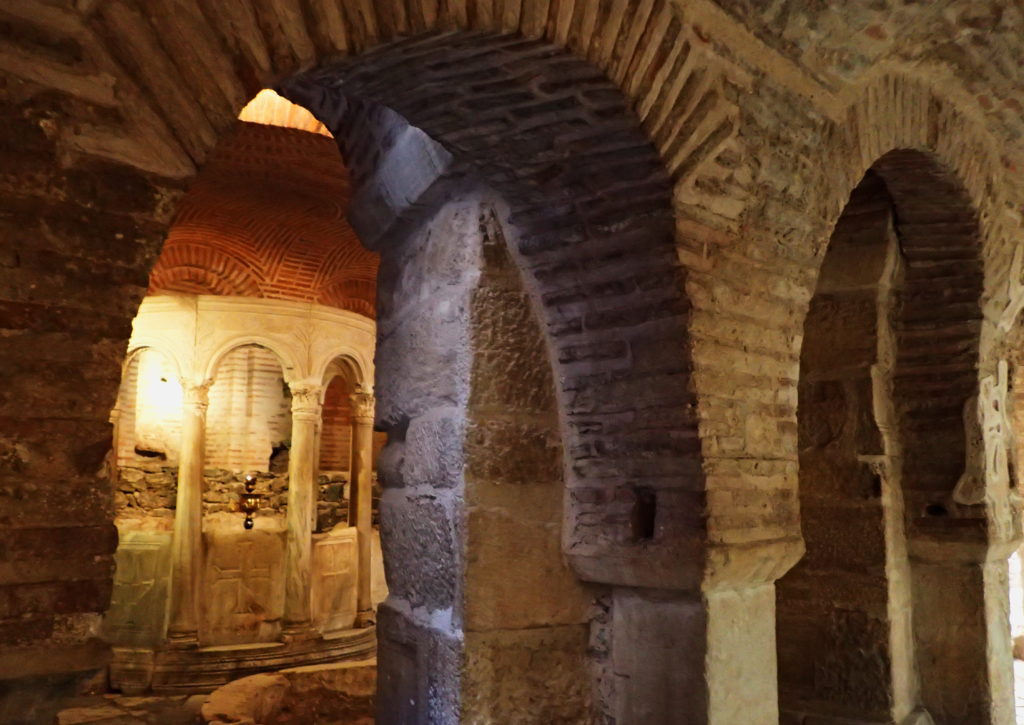
If you have time for just one of the many churches in Thessaloniki, visit Agios Dimitrios. This five-aisled basilica above the Roman Agora, overlooking the Thermaikos, is the Church of Thessaloniki’s Patron Saint. The feast day of Agios Dimitrios (October 26th) brings with it the celebration of the city’s liberation from Ottoman rule in 1912.
There was once a Roman bath on the site of the church. This is where Agios Dimitrios was martyred. The crypt with its fountain – site of the former bath – is now a deeply atmospheric exhibition space, were you can see items related to the church’s history and excavations of the site.
There was another church on this site in the 4th century. In the 7th century, a larger church replaced it. During the Ottoman era, Agios Dimitrios became the Kasimiye mosque, during which time a small portion of it remained available for Christian worship. The church was then nearly destroyed in the fire of 1917 and was reconsecrated in 1948.
Don’t Miss: The Original Mosaics, the Venetian Tomb, and the Recycled Columns
Splendid mosaics from the 6th and 7th centuries survived the fire. So did the distinctively Italianate tomb of Loukas Spandounis, a 15th C merchant of Thessaloniki. You can spot the tomb high on the northwestern wall of the nave, next to an arch. Many of the columns on either side of the nave are from earlier structures. The different colors of marble and styles of capitals- including some with rams’ heads and eagles- adds variety to the interior.
Agios Dimitrios is a site of pilgrimage, drawing crowds of the faithful throughout the day.
You can find more details and history here: Agios Dimitrios Thessaloniki – Church and Patron Saint.
Agios Dimitrios: 97 Agiou Dimitriou St. (+30) 2310 270 008. Daily, 6:00 – 22:00 (Crypt: Tuesday – Sunday, 8:00 – 14:00)
Agias Sophias- The Central Church of Thessaloniki
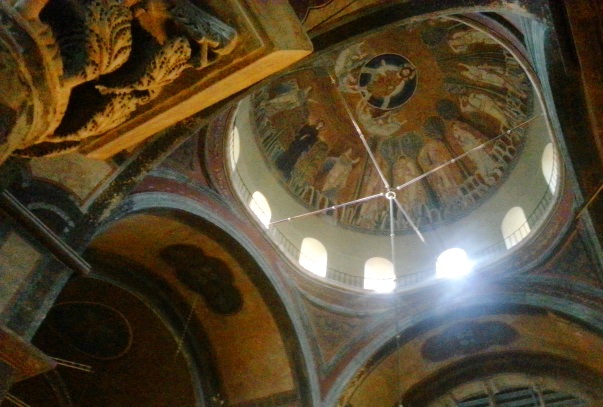
Agia Sophia is one of the most significant Churches in Thessaloniki, a defining spiritual and cultural monument. It’s in the city’s historical center, in a large square of the same name.
From the 8th C until its conversion into a mosque during the Ottoman era, Agia Sophia was the great cathedral church of Thessaloniki. A five aisled basilica- dedicated to Agios Markos- was originally built here in the 4th C. This was likely destroyed in an earthquake and subsequent fire in the 7th C.
The present church, which is a classic cross-in-square church with a dome, dates from the 8th C.
Don’t Miss: Mosaics Representing Different Eras
The church’s mosaics represent different eras. In the apse over the altar, a mosaic of the cross is an early example of the austere aesthetic of the iconoclastic period (726 – 787). The glorious 9th-century mosaic in the dome depicts the Ascension of Christ, with angles on either side. On the lower part of the dome, we see the Apostles and the Virgin Mary with two archangels, who point to the divine presence.
The deep jewel tones of Agia Sophia’s vast interior are almost quenching. Much of the decoration – including intricate abstract and botanical motifs, and tromp l’oeil marbling on the walls – dates from the Ottoman era.
Agia Sophia: Plateia Agias Sophias at Agias Sophias and Ermou Streets. (+30) 2310 270 253 Daily 7:00 – 13:00 and 18:00 – 19:30
Church of the Panagia Achieropoietos- One of the Oldest Churches in Thessaloniki
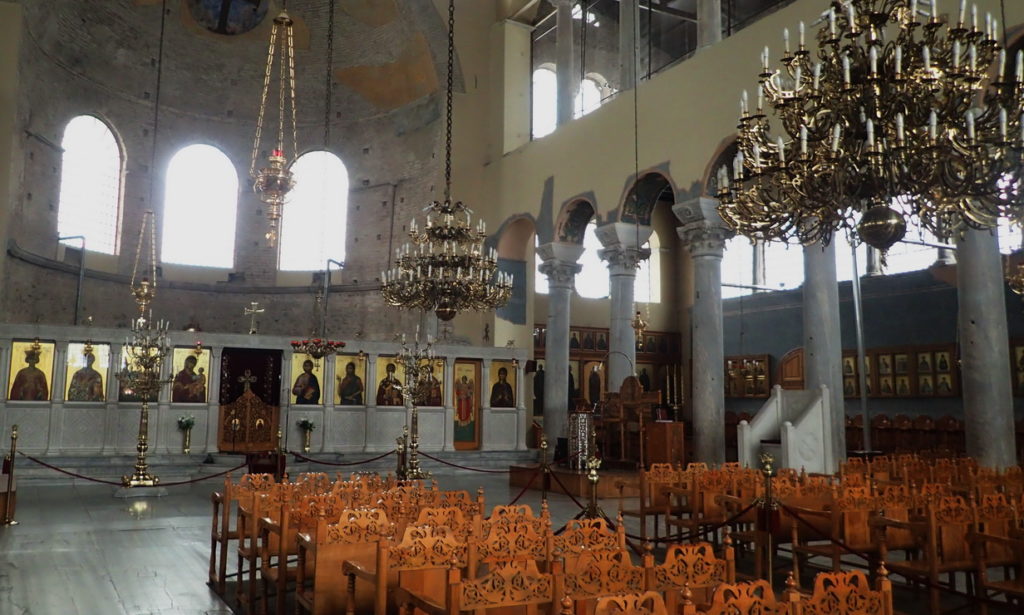
This three-aisled basilica of the 5th C, built over a complex of Roman baths, was originally dedicated to the Virgin Mary. The name “Achieropoitos,” which means “not made by human hands,” was first seen in a 14th C document. There was likely once a miraculous icon of the Virgin Mary here by that name.
Don’t Miss: The Theodosian Columns and the Historic Inscription
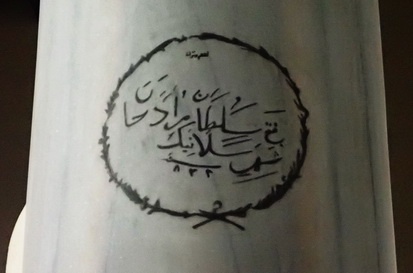
Beautiful mosaics decorate inside of the arches of the colonnade. These depict Christian symbols as well as botanical and geometric motifs and animals. The columns themselves are of interest. These ornate Theodosian (much like Corinthian) capitals came from Constantinople, of white marble of Proconnesos. On the southern aisle, some murals of the 13th C are barely discernable. The figures are the military saints – “The Forty Martyrs of Sebaste.” These were Roman soldiers martyred for their faith in 320.
The Achieropoietos Church has not been a Christian Church throughout the history of the city. On a column of the northern colonnade, you can easily make out an inscription in Arabic script, commemorating the fall of Thessaloniki to Murad II, in 1430. The Achieropoietos became the Eski Tzami (old mosque). It was the first of the churches in Thessaloniki that the Ottomans converted for Islamic worship. It remained the main mosque of the city throughout Thessaloniki’s Ottoman era.
The Achieropoietos church has played an important role in the life of the city in times of crisis. Victims of the great fire of 1917 found shelter here, as did refugees fleeing Asia Minor after the catastrophe of 1922.
Church of the Panagia Achieropoietos: 56 Agias Sophias Street (above Egnatia), (+30) 2310 227 369 Daily 7:30 – 12:00, and 17:30 – 18:30.
Panagia Chalkeon Thessaloniki
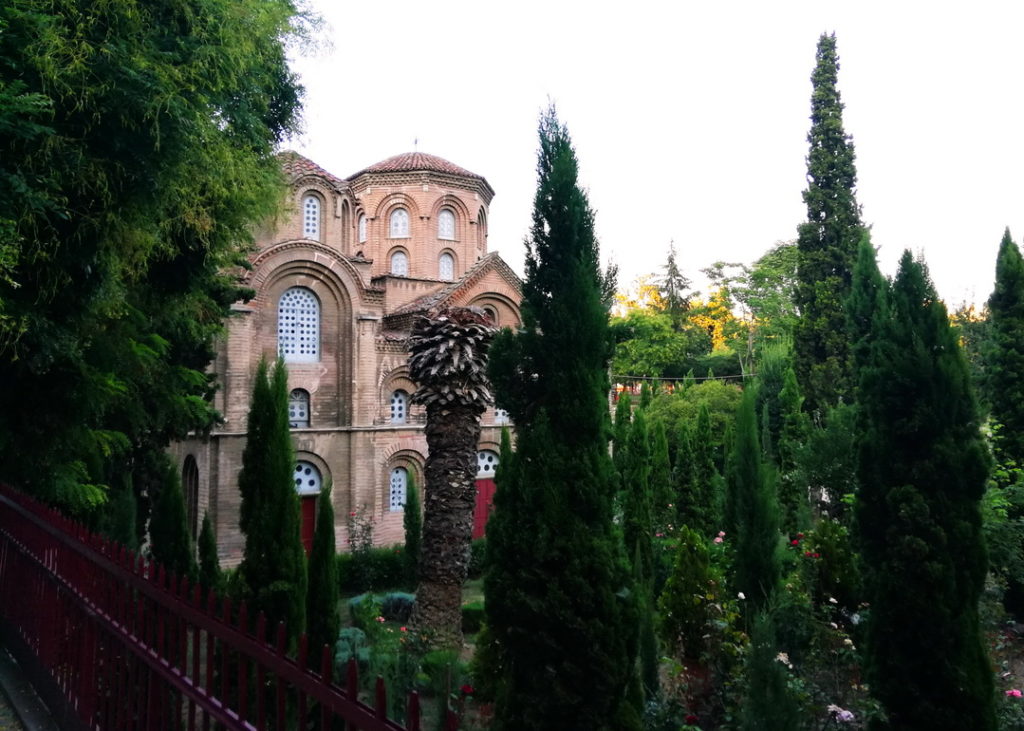
“Chalkos” means “copper.” The 11th C church , “The Virgin of the Copper Smiths” takes its name from the traditional occupation of this part of town. There have always been copper smiths in this corner of Thessaloniki. In fact, the church became the “Kazancilar Camii” in the Ottoman era -which means “The Mosque of the Copper Smiths.” And there are still copper smiths in the neighborhood today.
The Panagia Chalkeon has one of the best settings of a church in Thessaloniki. It’s in a garden of tranquility, below street level at the corner of a plaza in the busiest part of the urban center. An inscription on the lintel of the west entrance – “This once profane place….” – refers to the pagan sanctuary that was once here. This isn’t surprising, as the ancient Roman Forum is just a few paces to the north from here.
Don’t Miss: The Constantinople-Style Details and the Original Wall Paintings
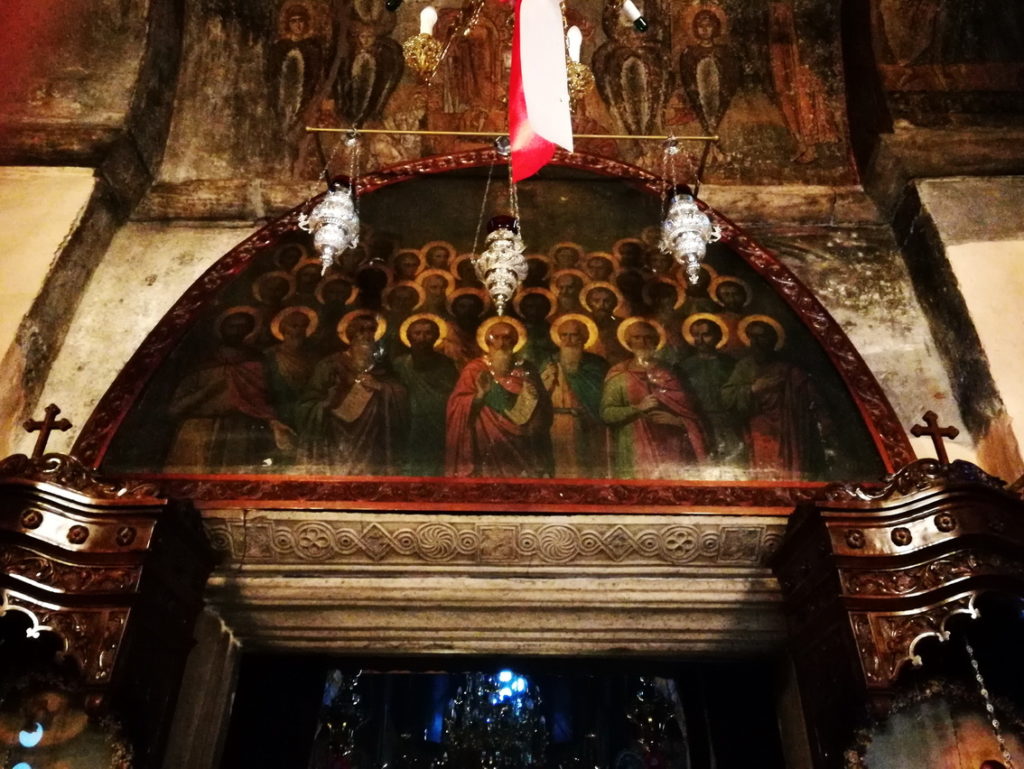
This domed, four-columned, cross-in-square church is typical of the Constantinople style. Because of its brick construction, it also went by the popular name “the red church.” The Panagia Chalkeon’s exterior is beautifully complex. You’ll find carved arches, apses, and semi-circular columns which are also usual in the churches Constantinople.
The interior, which feels high for the size of church, is dramatic yet intimate. Original wall paintings of scenes from the life of Christ- the Nativity, the Presentation in the Temple, the Adoration of the Magi, and Pentecost- survive, but not in good condition. The Nativity and the Presentation in the Temple are the easiest to see. In the sanctuary apse, there is a mural of the Last Supper, and above this is the Virgin Mary in a pose of supplication between two angels. As in Agia Sophia, in the dome is a depiction of the Ascension of Christ.
Panagia Chalkeon: 2 Chalkeon St. (above Egnatia), (+30) 2310 272 910. Daily 7:00 – 12:00 and 17:00 – 19:00
Church of Osios David (also called the Latomou Monastery)
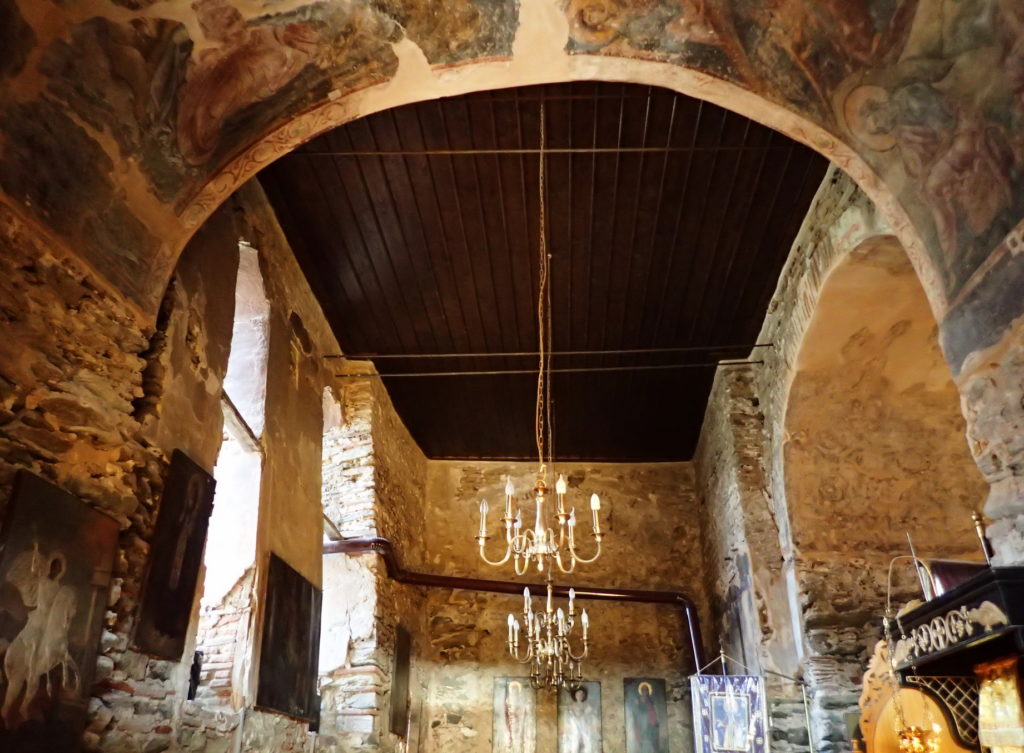
One of earliest and smallest churches in Thessaloniki, the late 5th C or early 6th C Osios David offers an intimate and almost mysterious experience. The location, at the end of a tangle of narrow alleys high in the romantic upper town, adds to the sense of mystery. The earlier name of Latomou means “quarry,” for the quarries that were once nearby.
The church has seen alterations over the centuries. Some of the western section of the church – the original entrance – is missing. The entrance is now in the south; you’ll find the altar not before you, but rather to the right as you enter.
A visit to Osios David is a highlight of the Old Town – Ano Poli experience.
Related post: Things to Do in Old Town Thessaloniki – Ano Poli
Osios David: near Epimenidou Street, in the old town (Ano Poli). Monday – Saturday 11:00 – 15:00, Sunday 7:00 – 12:00
Don’t Miss: The Best Mosaic in a Church in Thessaloniki
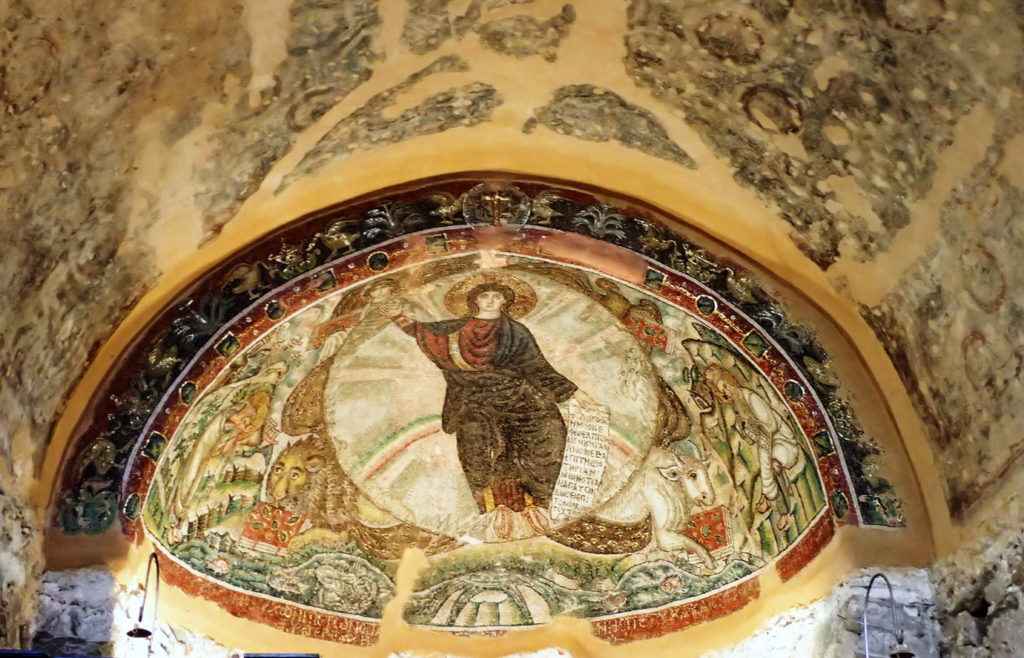
As you step down into the semi-darkness of the church, you will see one of the finest mosaics you can imagine. UNESCO has designated this splendid mosaic one of the great masterpieces of early Christian art.
The vision of Ezekiel fills the apse. A rare depiction of Christ as an adolescent, with no beard, is at the center. A scroll is in his left hand. He is seated on a rainbow, and at his feet the rivers of paradise flow into the river Jordan.
The four Evangelists surround Christ. We see Mathew as a winged man, John as an eagle, Mark as a lion, and Luke as an ox. At the left of the mosaic is a fearful and vividly expressive Ezekiel. A calm Habakkuk on the right balances the image.
The frescoes of the southern arch date from the Comnenian period (the late 11th C to the late 12th C- the Comnenos dynasty). These scenes of the life of Christ include the Nativity and the Baptism of Christ.
Agios Nikolaos Orphanos
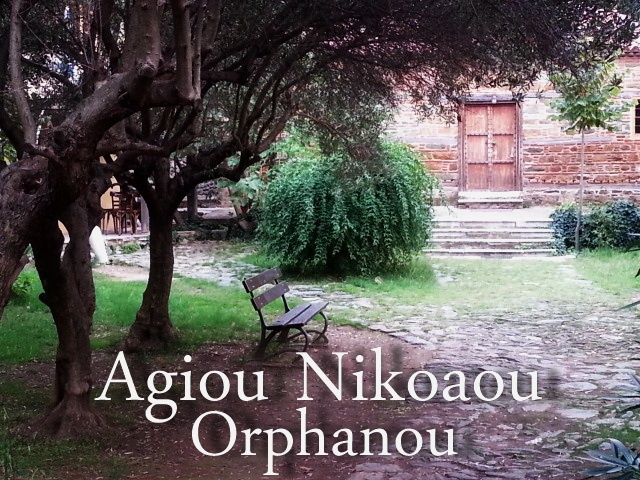
Also in the upper town, Agios Nikolaos Orphanos- like Osios David- rewards the visitor with a sense of discovery. A high stone wall surrounds the 14th C church. Enter through the gate on Irodotou Street, and you will find yourself in a rambling, meditative garden. The origin of the church’s name could be either the family name of the church’s founder, or an allusion of the kindness of St. Nicholas to widows and to orphans. The church was likely founded by the Serbian king Milutin, whose marriage to the Byzantine princess Simonis, daughter of the emperor Andronikos II Paleologos, was celebrated in Thessaloniki. Murals in the church of Agios Georgios Gorgos and Clement of Ochrid (popular Saints in Serbia) support this thought.
Many of the churches in Thessaloniki became mosques during the Ottoman era, but Agios Nikolaos Orphanos remained a Christian church throughout.
Don’t Miss: The Spectacularly Detailed Narrative Murals of the Paleologian Renaissance.
This church is famous for the excellence of its murals, which cover nearly the whole of the interior. They’re in very good condition. These murals are fine examples of the style of the Paleologian Renaissance. This was the late Byzantine period of 1261- when the Latin crusaders were driven from Constantinople, to 1453- when Constantinople fell to the Ottoman Turks.
The Paleologian Renaissance style had great narrative power, with realistic figures full of expression. In a period when many could not read, it was very useful to have pictures that truly tell their stories, like the Wedding of Canna, the Kiss of Judas betraying Christ, and the Dormition of the Virgin.
Agios Nikolaous Orphanos: 1 Irodotou, old town (Ano Poli). Tuesday – Sunday, 9:00 – 15:00

